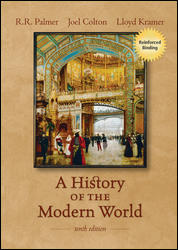 
History of the Modern World, 10th Edition (Palmer)Chapter 27:
The Changing Modern WorldLearning ObjectivesChapter 27 teaches students about:
The unexpected burdens of economic slow-downs and long-term unemployment in western Europe, and the subsequent restructuring of those economies. |
 |  |  |
The “third way” pursued by moderate politicians in the post-Cold War era, which combined growth-inducing economic policies with concern for social issues. |
 |  |  |
Japan’s economic and political crises. |
 |  |  |
The continuing process of European integration. |
 |  |  |
The nature of the new economy, its volatility, its social impact, and the increasing levels of globalization that resulted. |
 |  |  |
The achievements of science, which were countered by critiques of scientific advance and developments in the humanities and creative arts. |
 |  |  |
The challenges to religion in the contemporary world, which were largely the result of tensions between modernism and fundamentalism. |
 |  |  |
The impact of social movements in the late twentieth century. |
 |  |  |
The new forms of war that appeared late in the century, often driven by ethnic and religious tensions. |
 |  |  |
The debate over the U.N.’s role in world affairs, as well as the discussions surrounding U.S. leadership. |
 |  |  |
The impact of the September 11, 2001 attacks and the subsequent war on terror undertaken by the United States in Iraq and Afghanistan. |
 |  |  |
The population explosion and environmental concerns. |
 |  |
|





